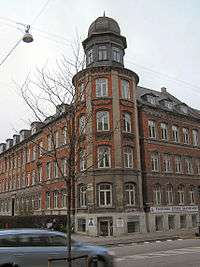H. C. Ørsteds Vej

H. C. Ørsteds Vej is a street in the Frederiksberg district of Copenhagen, Denmark. It runs from Åboulevard on the border with Nørrebro in the north to Gammel Kongevej in the south, linking Griffenfeldsgade with Alhambravej and further south Enghavevej-Kingogade with Griffenfeldsgade.
History

The southern part of H. C. Ørstedsvej was established in 1852.[1] In 1860, Det Danske Gaskompagni ("The Danish Gas Company") opened Frederiksberg's first gasworks at the street. It closed in 1890 when the new Frederiksberg Gasworks opened at Flintholm a few kilometres outside the expanding town centre.[2]

The architect Henning Wolf, who served as Frederiksberg's firstcity architect from 1858 to 1869, created a masterplan for a neighbourhood of single-family detached homes between the two streets. In 1872, it resulted in an extension of H. C. Ørstedsvej all the way to the Ladegård Canal, on the bordfer between Frederiksberg and Copenhagen municipalities, where Parcelbroen ("The Lot Bridge") connected it to Griffenfeldsgfade in Nørrebro. Other elements in his plan was the extension of Kastanievej to H. C. Ørstedsvej, establishment of Alhambravej, Uraniavej, Mynstersvej, Svanholmsvej and Forhåbningsholms Allé.[3]
In 1873, M.I. Ballins Sønner (from 1918 Ballin & Hertz), a tannery and manufacturer of leather goods, built a factory at No. 48–50. The company moved to Valby in 1924 and its buildings on H. C. Ørsteds Vej were later demolished.
The street was formerly crossed by the tracks of the Nordbanen and Klampenborgbanen railway lines which originally branched off from the Copenhagen–Frederisberg–Roskilde railway. The railway ccrossing disappeared in the 1930s with the opening of the Boulevard Line in the 1930s.
Notable buildings and residents

The building on the corner of H. C. Ørsteds Vej and Kastanievej is the one for which Johannes Jørgensen's periodical Tårnet ("The Tower") was named. He lived on the top floor between 1891 and 1893. The four-storey Functionalist property at No. 54 is from 1934 and was designed by Edvard Thomsen for his father. It contains a post office on the ground floor and apartments on the upper floors.[4][5]
Handskemagerforeningens Stiftelse (No. 60–62) was built for the Glovemakers' Association in 1880 to design by Alfred Råvad and August Johansen.
Åhusene ("The River Houses") at the corner with Åboulevard were designed by Ulrik Plesner and are from 1936 - 1938.[6]
See also
References
- ↑ "1852" (in Danish). Selskabet for Københavns Historie. Retrieved 2014-10-25.
- ↑ "Historien" (in Danish). Vejlauget FAB. Retrieved 2010-01-04.
- ↑ "Hans Christian Henning Wolff" (PDF) (in Danish). .byogland.d. Retrieved 2014-10-27.
- ↑ "Funktiononalistiske boliger på Frederiksberg" (in Danish). Kulturstyrelsen. Retrieved 2014-10-26.
- ↑ "Frederiksberg, H. C. Ørsteds Vej 54". arkark.dk. Retrieved 2014-10-25.
- ↑ "Åhusene, København". arkark.dk. Retrieved 2014-10-25.
External links
Coordinates: 55°40′51″N 12°32′56″E / 55.6808°N 12.5489°E